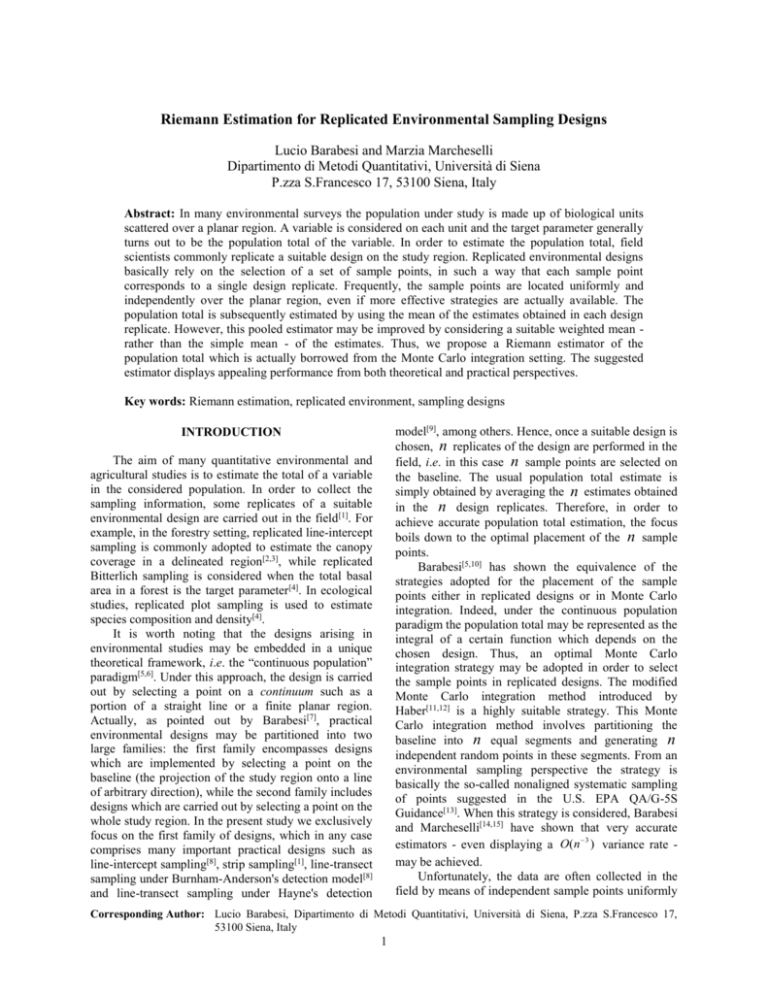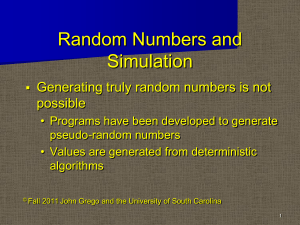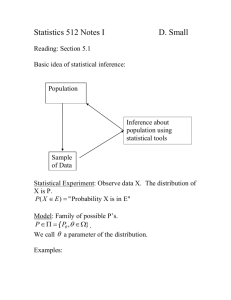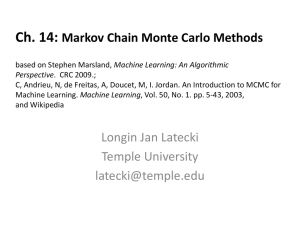Riemann Estimation for Replicated Environmental Sampling Designs
advertisement

Riemann Estimation for Replicated Environmental Sampling Designs
Lucio Barabesi and Marzia Marcheselli
Dipartimento di Metodi Quantitativi, Università di Siena
P.zza S.Francesco 17, 53100 Siena, Italy
Abstract: In many environmental surveys the population under study is made up of biological units
scattered over a planar region. A variable is considered on each unit and the target parameter generally
turns out to be the population total of the variable. In order to estimate the population total, field
scientists commonly replicate a suitable design on the study region. Replicated environmental designs
basically rely on the selection of a set of sample points, in such a way that each sample point
corresponds to a single design replicate. Frequently, the sample points are located uniformly and
independently over the planar region, even if more effective strategies are actually available. The
population total is subsequently estimated by using the mean of the estimates obtained in each design
replicate. However, this pooled estimator may be improved by considering a suitable weighted mean rather than the simple mean - of the estimates. Thus, we propose a Riemann estimator of the
population total which is actually borrowed from the Monte Carlo integration setting. The suggested
estimator displays appealing performance from both theoretical and practical perspectives.
Key words: Riemann estimation, replicated environment, sampling designs
model[9], among others. Hence, once a suitable design is
chosen, n replicates of the design are performed in the
field, i.e. in this case n sample points are selected on
the baseline. The usual population total estimate is
simply obtained by averaging the n estimates obtained
in the n design replicates. Therefore, in order to
achieve accurate population total estimation, the focus
boils down to the optimal placement of the n sample
points.
Barabesi[5,10] has shown the equivalence of the
strategies adopted for the placement of the sample
points either in replicated designs or in Monte Carlo
integration. Indeed, under the continuous population
paradigm the population total may be represented as the
integral of a certain function which depends on the
chosen design. Thus, an optimal Monte Carlo
integration strategy may be adopted in order to select
the sample points in replicated designs. The modified
Monte Carlo integration method introduced by
Haber[11,12] is a highly suitable strategy. This Monte
Carlo integration method involves partitioning the
baseline into n equal segments and generating n
independent random points in these segments. From an
environmental sampling perspective the strategy is
basically the so-called nonaligned systematic sampling
of points suggested in the U.S. EPA QA/G-5S
Guidance[13]. When this strategy is considered, Barabesi
and Marcheselli[14,15] have shown that very accurate
estimators - even displaying a O(n 3 ) variance rate may be achieved.
Unfortunately, the data are often collected in the
field by means of independent sample points uniformly
INTRODUCTION
The aim of many quantitative environmental and
agricultural studies is to estimate the total of a variable
in the considered population. In order to collect the
sampling information, some replicates of a suitable
environmental design are carried out in the field [1]. For
example, in the forestry setting, replicated line-intercept
sampling is commonly adopted to estimate the canopy
coverage in a delineated region[2,3], while replicated
Bitterlich sampling is considered when the total basal
area in a forest is the target parameter[4]. In ecological
studies, replicated plot sampling is used to estimate
species composition and density[4].
It is worth noting that the designs arising in
environmental studies may be embedded in a unique
theoretical framework, i.e. the “continuous population”
paradigm[5,6]. Under this approach, the design is carried
out by selecting a point on a continuum such as a
portion of a straight line or a finite planar region.
Actually, as pointed out by Barabesi[7], practical
environmental designs may be partitioned into two
large families: the first family encompasses designs
which are implemented by selecting a point on the
baseline (the projection of the study region onto a line
of arbitrary direction), while the second family includes
designs which are carried out by selecting a point on the
whole study region. In the present study we exclusively
focus on the first family of designs, which in any case
comprises many important practical designs such as
line-intercept sampling[8], strip sampling[1], line-transect
sampling under Burnham-Anderson's detection model[8]
and line-transect sampling under Hayne's detection
Corresponding Author: Lucio Barabesi, Dipartimento di Metodi Quantitativi, Università di Siena, P.zza S.Francesco 17,
53100 Siena, Italy
1
placed over the baseline[8]. This sampling strategy is
equivalent to the crude Monte Carlo integration
method, which solely produces a population total
estimator with a O ( n 1 ) variance rate. However, it is
again possible to achieve accurate estimation by
adopting the Riemann Monte Carlo estimators[16]. The
suggested Riemann Monte Carlo estimator of the
population total is based on the weighted mean - rather
than the simple mean - of the estimates obtained in the
n replicates. Even if the Riemann Monte Carlo
estimator is biased, it displays a O ( n 2 ) mean square
error and hence it improves over the simple mean.
where I A is the usual indicator of a set A. Incidentally,
it is at once apparent that y(u) is simply the HorvitzThompson estimate of Ty when location u is selected.
The total intensity of the variable of interest over the
study region turns out to be
1
1
0
0 l =1
N
yl
y(u) du =
I{uPl } du = Ty ,
l
i.e. an integral representation is achieved and hence the
estimation of Ty reduces to an integration problem.
Hence, the strategies adopted for the Monte Carlo
quadrature of an integral can be adopted in order to
choose n sample points (u1 , u2 , , un ) on the baseline.
When the n sample points are independently and
randomly chosen, the crude Monte Carlo integration
strategy is actually adopted. In this case, (u1 , u2 , , un )
are the realization of n independent random variables
(U1 ,U 2 , ,U n ) uniformly distributed over the baseline.
Hence, the Monte Carlo estimator is given by
1 n
(2)
Ty = Ty (U1 ,U 2 , ,U n ) = y(U i ) .
n i =1
It is at once apparent that the pooled estimator (2)
is the mean of n Horvitz-Thompson estimators
corresponding to the n design replicates. Actually, this
is the usual estimation procedure adopted in replicated
environmental sampling designs. Indeed, once the
sample points are positioned and the data are collected,
n Horvitz-Thompson estimates are obtained for each
design replicate and they are subsequently averaged in
order to achieve an overall estimate for T y . Obviously,
PRELIMINARIES
Let us consider a well-defined planar study region
and a population of N units scattered over this region at
fixed locations. Furthermore, let ( y1 , y2 , , yN ) be the
values of the target variable on the N units, in such a
way that
N
Ty = yl
l =1
represents the population total. Moreover, let us assume
that the estimation of Ty is performed using the
replication of a design which is implemented by
selecting a sample point on the baseline. Without loss
of generality and for the sake of simplicity, let us
suppose that the baseline is given by the interval
(0,1) . Moreover, let u be the position of a point
selected on the baseline.
Once a suitable design is chosen, the inclusion set
l-th unit is a suitable interval contained in
Pl
in this section the same procedure has been described
from a Monte Carlo integration perspective.
It is straightforward to show that Ty is unbiased
the baseline[10] and the l-th unit is selected - and yl is
measured - if u Pl . As an example, let us consider a
with a O ( n 1 ) variance rate. In addition, Var[Ty ] may
population of plants and let yl be the biomass of the lth plant, in such a way that the target parameter is the
total biomass in the forest. If line intercept sampling is
adopted, the inclusion sets are the projections of the
plant crowns onto the baseline. Indeed, a plant is
selected if the corresponding crown is intercepted by a
line perpendicular to the baseline at location u.
In order to obtain a suitable representation for Ty ,
be unbiasedly estimated by means of
n
1
ˆ Ty ] =
Var[
[ y(U i ) Ty ]2 .
n(n 1) i 1
However, the crude Monte Carlo strategy precludes
the small variance rates for the pooled estimator which
can be achieved when more refined Monte Carlo
strategies are adopted[14,15]. Accordingly, the aim of the
following section is to introduce an estimator with
elevated performance, even if the sample points are
collected using the crude Monte Carlo strategy.
it is worth noting that, if solely the l-th unit is
considered, the intensity of the target variable over the
l-th inclusion set is given by yl / l , where
1
l = I{uP }du is the length of Pl . Hence, the
THE RIEMANN MONTE CARLO ESTIMATOR
l
0
intensity of the variable at location u is given by
N
y (u ) =
l =1
yl
l
In order to improve on estimator (2), it is
worthwhile to consider a weighted estimator of type
I{uPl } ,
Ty T (U1 , U 2 ,
(1)
,U n )
(3)
n
= wi (U1 , U 2 ,
i 1
2
, U n ) y (U i ) ,
where the wi (U1 ,U 2 ,
that
n
A SIMULATION STUDY
,U n ) s are positive weights such
w (U1 ,U 2 ,
i =1 i
,U n ) = 1 .
If
In order to assess the small-sample properties of
estimator (4) with respect to estimator (2), a simulated
experiment dealing with line intercept sampling has
been considered. In this setting, it is worth noting that
an interesting use of line-intercept design is described
by Thompson[8]: if the study region is snowed and the
total of a certain animal species (such as wolverines or
arctic wolves) is the target parameter, the selected
transects are flown under appropriate weather
conditions with observers in the aircraft looking for
animal tracks in the snow. Once a track is encountered,
it is followed in each direction and mapped. Hence, the
animal total is estimated on the basis of the estimated
track total[17].
The previous survey setting was mimicked by
simulating three populations of twenty tracks on the
unit square. Thus, the target parameter was given by the
population total, i.e. Ty=N=20. The three populations
were settled in such a way that the first population
consisted of lines randomly located, the second
population consisted of lines positioned with a slight
trend, while the third population consisted of lines
positioned with a marked trend. The three simulated
populations are displayed in Fig. 1. These populations
of lines may be considered quite representative of real
situations[8].
wi (U1 ,U 2 , ,U n ) = wi , i.e. if the wi s are non-random,
it is straightforward to prove that estimator (3) is
unbiased and the corresponding variance is minimum
when wi 1/ n . In this case, estimator (3) actually
reduces to estimator (2). Accordingly, the weights must
be chosen as random functions in order to improve on
estimator (2). First, it is at once apparent that estimator
(3) may expressed as:
n
Ty = wi (U (1) ,U (2) ,
i 1
where (U (1) , U (2) ,
,U ( n ) ) y(U (i ) ) ,
, U ( n ) ) represents the order statistic
corresponding to (U1 ,U 2 , ,U n ) . Hence, a reasonable
choice
of
the
weights
is
given
by
wi (U (1) ,U (2) , ,U ( n ) ) = U (i 1) U (i ) , assuming that
U (0) = 0 and U ( n 1) = 1 . In this case, estimator (3)
reduces to the usual Riemann Monte Carlo estimator[16]
given by:
n
Ty = (U (i 1) U (i ) ) y(U (i ) ) .
(4)
i 0
Robert and Casella[16] have proven that (4) is
biased with a O ( n 2 ) mean square error when y has a
bounded derivative. However, in the present setting y
does not achieve this regularity condition. Indeed, it is
at once apparent that the function y defined in (1) is an
elementary function. In any case, it can be proven that
Ty is biased with a O ( n 2 ) mean square error even if y
is solely an elementary function (Result 1 in the
Appendix). Hence, estimator (4) is preferable to
estimator (2), at least in a large-sample setting.
Fig. 1: The three simulated populations of lines
For the sake of simplicity, it was assumed that the
baseline corresponded to the base of the unit square.
Since the line-intercept design was assumed, the
inclusion sets of the lines were obviously given by their
projections onto the baseline. The three functions y
corresponding to the simulated populations are reported
in Fig. 2.
Moreover, Ty generally displays a O ( n 1 ) bias (see the
Remark in the Appendix). However, on the basis of the
same Remark, if the sampling design is slightly
modified to ensure that y is null in the narrow interval
(1 ,1] (where is a small positive constant), then
Ty achieves a o(n 1 ) bias. This requirement may be
easily achieved in practice by suitably modifying the
inclusion probability of the right-border units.
80
80
80
60
60
60
As to the variance estimation of Ty , it can be shown
40
40
40
that
20
20
20
1
Vˆ = 2
n
n
[ y(U
i 0
( i 1)
) y(U (i ) )]2
0.2
(5)
0.4
0.6
0.8
1
0.2
0.4
0.6
0.8
1
0.2
0.4
0.6
0.8
1
Fig. 2: The three functions y corresponding to the
simulated populations of lines
is a consistent estimator for E[(Ty Ty ) 2 ] (see Result 2
in the Appendix). Obviously, when y is null in
(1 ,1] , the estimator Vˆ turns out to be consistent
The sample sizes n = 20,30,40 were considered in
the simulation. For each sample size and for each
population, B = 2,000 simulations of replicated line
for Var[Ty ] .
3
intercept designs were carried out. For each simulation,
the realizations of estimators (2) and (4) were
computed. On the basis of the B estimates, the
simulated bias, the simulated mean square error (MSE)
and the simulated relative efficiency (RE) - i.e. the ratio
of the simulated mean square errors - were computed
for the estimators (2) and (4). The corresponding results
were reported in Table 1.
By using expression (7) in estimator (4), it follows
that
m
(ak ak 1 )
n
Ty Ty =
k 1 i 1
(U (i 1) bk ) I{U
( i ) bk U ( i 1) }
and hence the mean square error of Ty may be
expressed as
m
Table 1:
Simulated performance indexes of estimators
Population
n
Random
Slight trend
Marked trend
20
30
40
20
30
40
20
30
40
Bias(MSE)
Bias(MSE)
of Ty
of Ty
0.01 (5.24)
0.02 (3.43)
0.01 (2.57)
-0.04 (17.88)
-0.01 (11.80)
-0.01 (8.75)
0.02 (20.06)
0.00 (13.23)
0.01 (9.52)
-0.50 (4.09)
-0.21 (2.25)
-0.10 (1.41)
-0.26 (19.76)
-0.22 (10.70)
-0.08 (7.73)
-0.12 (10.40)
-0.03 (5.25)
-0.05 (3.15)
Ty
and
E[(Ty Ty ) 2 ] = (ak ak 1 ) 2 n (bk )
Ty
k 1
m
RE
2
1 h < k
(8)
(ah ah 1 )(ak ak 1 ) n (bh , bk ) .
Therefore, in order to obtain the large-sample
1.28
1.52
1.81
0.91
1.10
1.13
1.93
2.52
3.02
properties of E[(Ty Ty ) 2 ] - and consequently of its
estimator (5) - it suffices to analyze the asymptotic
properties of n ( x) and n ( x, z ) as n .
Result 1: For each x, z (0,1) such that x < z , it
follows that
n ( x) 2n 2 , n ( x, z ) n 2 .
(9)
From Table 1, it is at once apparent that estimator
(4) always outperforms estimator (2), except for the
second population and N=20. The performance of the
Riemann estimator obviously increases as n increases.
The best performance is achieved for the third
population of lines, i.e. for the most irregular y
function. Further simulations (not reported here) seem
to confirm that this behavior generally occurs, even if
the superiority of (4) over (2) is not marked for very
small n values (say n less than 10 ). Finally, it should
be emphasized that the bias of (4) is always negative in
the simulation, a result which is consistent with the
findings in the Remark of the Appendix.
Moreover, Ty has a O(n 2 ) mean square error such
that
E[(Ty Ty ) 2 ]
1
n2
m
k 1
(ak ak 1 ) 2
am2
.
n2
(10)
Proof: Since the joint probability density function of
(U ( i ) , U ( i 1) ) is given by
n 2 i 1
n i 1
g (t , u ) = n(n 1)
I{t u} ,
t (1 u )
i 1
i = 1, 2, , n 1 ,
Appendix: Let y be an elementary function, i.e.
m
y(u) = ak I{bk u bk 1 } ,
it turns out that
(6)
n ( x) = cn
k =1
where (a1 , a2 ,
, am ) are given constants. In turn,
are
constants
such
that
(b1 , b2 , , bm 1 )
b1 b2 bm1 and b1 = 0 and bm 1 = 1 . It is
straightforward to prove that (6) may be expressed as
(7)
k =1
where a0 = 0 .
For each x (0,1) , let us assume that
n
n ( x) = E[(U (i 1) x)2 I{U
i =0
( i ) x U( i 1) }
],
n i 1
n ( x, z ) = E[(U (i 1) z )
g (u1 , u2 ,
i =1 j =0
( i ) z U ( i 1) , U ( j ) z U ( j 1) }
n 2 i
n i 2
,
x (1 x)
i
i =1
Since cn d n = o(n 2 ) , the first part of (9) follows.
In addition, since the joint probability density function
of (U (1) , U (2) , , U ( n ) ) is given by
while for each x, z (0,1) such that x < z , let us
assume that
(U ( j 1) x) I{U
n 1
where
cn = E[(U(1) x)2 ] (1 x)2 P(U( n) x) .
Hence, on the basis of Newton's formula it turns
out that
2
n ( x) = cn
(1 d n ) ,
(n 2)(n 1)
where
n2
n 2 i
n i 2
d n = (1 x) n 2
.
x (1 x)
i
i=n
m
y(u) = (ak ak 1 ) I{bk u 1} ,
2
(n 1)(n 2)
, un ) = n! I{u u2
it turns out that
].
4
1
un }
,
E[(U (i 1) z )(U ( j 1) x)
where
n!x j ( z x)i j 1 (1 z )n i 1
j!(i j 1)!(n i 1)!
for each j i 1 and i = 2,3, , n 1 . Thus, since
max i 0,1,
I{U
( i ) z U ( i 1) , U ( j ) x U ( j 1) }
]=
n!(1 z ) n i 1
(n i 1)!
n 1
n ( x, z )
i =2
n 1
i =2
x j ( z x)i j 1
j!(i j 1)!
m
since
(ak ak 1 ) 2
k 1
m
am2
,
n2
(ak ak 1 ) = am .
k =1
(ak ak 1 )
n
E[(U
k 1 i 0
( i 1)
bk ) I{U
( i ) bk U ( i 1)
}]
am
.
n
Hence, T y displays a negative large-sample bias.
In addition, if am = 0 , by means of reasoning similar to
Result 1, it can be easily proven that a o(n 1 ) bias is
achieved (with in turn a negative leading term). In this
case, since Bias[Ty ]2 = o(n 2 ), it follows that
Var[Ty ]
1
n2
m
(a
k 1
k
ak 1 )2 .
n .
Proof: By using (10), it suffices to prove that n 2Vˆ
m
k 1
(ak ak 1 )2 am2 .
Moreover, it should be noticed that
m
n 2Vˆ = (ak ak 1 )2 am2
k 1
m
2
1 h < k
(ah ah 1 )(ak ak 1 ) X hk ,
where X hk = i 0 I{U
n
( i ) bh U ( i 1) , U ( i ) < bk U ( i 1) }
0
11. Haber, S., 1966. A modified Monte-Carlo quadrature.
Mathematics of Computation, 20: 361-368.
12. Haber, S., 1967. A modified Monte-Carlo quadrature. II,
Mathematics of Computation, 21: 388-397.
13. U.S. Environmental Protection Agency, 2002. Guidance
on choosing a sampling design for environmental data
collection. EPA QA/G-5S, Washington DC, pp: 1-166.
14. Barabesi, L. and M. Marcheselli, 2003. A modified
Monte Carlo integration. Intl. Mathl. J., 3: 555-565.
15. Barabesi, L. and M. Marcheselli, 2005. Some largesample results on a modified Monte Carlo integration
method. J. Stat. Planning and Inference, 135: 420432.
16. Robert, C.P. and G. Casella, 2002. Monte Carlo
Statistical Methods. Springer, New York.
17. Fattorini, L. and M. Marcheselli, 2002. Empirical
investigation about statistical properties of abundance
estimates based on line-intercept and network sampling
of tracks. Stat. Methods and Applications 11: 217-226.
18. Massart, P., 1990. The tight constant in DvoretzkyKiefer-Wolfowitz inequality. Annals of Probability, 18:
1269-1283.
Result
2:
The
random
variable
2
ˆ
V / E [(Ty Ty ) ] converges almost surely to 1 as
converges almost surely to
(U (i 1) U (i ) ) converges almost surely to
Barabesi, L. and L. Fattorini, 1998. The use of
replicated plot, line and point sampling for estimating
species abundancies and ecological diversity.
Environ. and Ecolog. Stat., 5: 353-370.
2. Bonham, C.D., 1989. Measurements for Terrestrial
Vegetation. Wiley, New York.
3. Husch, B., C.I. Miller and T.W. Beers, 1982. Forest
Mensuration. Wiley, New York.
4. Schreuder, H.T., T.G. Gregoire and G.B. Wood,
1993. Sampling Methods for Multiresource Forest
Inventories. Wiley, New York.
5. Barabesi, L., 2004. Replicated environmental
sampling designs and Monte Carlo integration
methods: two sides of the same coin, invited paper in
the Proceedings of XLII Meeting of the Italian
Statistical Society, June 9-11, Bari, Italy.
6. Williams, M.S. and M. Eriksson, 2002. Comparing
the two paradigms for fixed area sampling in largescale inventories. Forest Ecol. and Manage., 168:
135-148.
7. Barabesi, L. and C. Pisani, 2002. Ranked set sampling
for replicated sampling designs. Biometrics, 58:
586-592.
8. Thompson, S.K., 2002. Sampling. Wiley, New York.
9. Overton, W.S., 1969. Estimating the Number of
Animals in Wildlife Populations. In Wildlife
Management Techniques. R.H. Giles (Ed.), The
Wildlife Society, Washington DC, pp: 405-455.
10. Barabesi, L., 2003.
A Monte Carlo integration
approach to Horvitz-Thompson estimation in
replicated environmental designs, Metron, LXI:
355-374.
Bias[Ty ] E[Ty Ty ] =
m
and
1.
Remark: By similar argumentation, it follows that
u > 0
REFERENCES
n!z i 1 (1 z ) n i 1
1
,
(n 1)(n 2)
i =2 ( n i 1)!(i 1)!
the second part of (9) follows. Moreover, on the basis
of (8) and (9), it turns out that
2 m
E[(Ty Ty ) 2 ] 2 ( ak ak 1 ) 2
n k 1
m
2
2 (ah ah 1 )(ak ak 1 )
n 1 h < k
1
n2
,n
Indeed,
on the basis of the Dvoretzky-Kiefer-Wolfowitz
inequality[18].
n 1
=
u = min k (uk 1 uk ) .
. Hence, the
result follows since
{X hk 0} { max (U(i 1) U(i ) ) u } ,
i =0,1, , n
5









